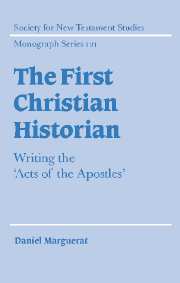Book contents
- Frontmatter
- Contents
- Preface
- 1 How Luke wrote history
- 2 A narrative of beginnings
- 3 The unity of Luke–Acts: the task of reading
- 4 A Christianity between Jerusalem and Rome
- 5 The God of Acts
- 6 The work of the Spirit
- 7 Jews and Christians in conflict
- 8 Ananias and Sapphira (Acts 5. 1–11): the original sin
- 9 Saul's conversion (Acts 9; 22; 26)
- 10 The enigma of the end of Acts (28. 16–31)
- 11 Travels and travellers
- Bibliography
- Index of passages
8 - Ananias and Sapphira (Acts 5. 1–11): the original sin
Published online by Cambridge University Press: 22 September 2009
- Frontmatter
- Contents
- Preface
- 1 How Luke wrote history
- 2 A narrative of beginnings
- 3 The unity of Luke–Acts: the task of reading
- 4 A Christianity between Jerusalem and Rome
- 5 The God of Acts
- 6 The work of the Spirit
- 7 Jews and Christians in conflict
- 8 Ananias and Sapphira (Acts 5. 1–11): the original sin
- 9 Saul's conversion (Acts 9; 22; 26)
- 10 The enigma of the end of Acts (28. 16–31)
- 11 Travels and travellers
- Bibliography
- Index of passages
Summary
The story of the judgement of God on Ananias and Sapphira (Acts 5. 1–11) is the most tragic episode in the book of Acts. The Lucan art of dramatization reaches the height of pathos: the tragic end of Ananias struck down by Peter's accusing word, his rapid burial, then the arrival of Sapphira ignorant of the dramatic event, her open lie followed by her death, announced with a tone of black humour (5. 9b). The pragmatic effect sought by the narrator is apparent in the text itself: ‘great fear seized all who heard of it’ (5. 5, 11). This is a story that is meant to provoke fear.
It must be said that the story, situated in the idyllic picture of the first Christian community which unfolds in chapters 2 to 5, strikes the reader with a narrative shock. What is the intention of the author of Acts? The violence to the reader is also theological: how can one justify the tragic disproportion between Ananias and Sapphira's crime and the sanction that strikes them? How can the absence of the typically Lucan offer of conversion (μετάνοια) be explained? Can Lucan ecclesiology endure this dualist vision of a pure community from which the sinner is excluded by death?
Furthermore, from an author with a reputation of aiming to soften the internal conflicts of the Church (6. 1–6; 15. 7–35), the brutal emergence of this crisis comes as a surprise.
- Type
- Chapter
- Information
- The First Christian HistorianWriting the 'Acts of the Apostles', pp. 155 - 178Publisher: Cambridge University PressPrint publication year: 2002



